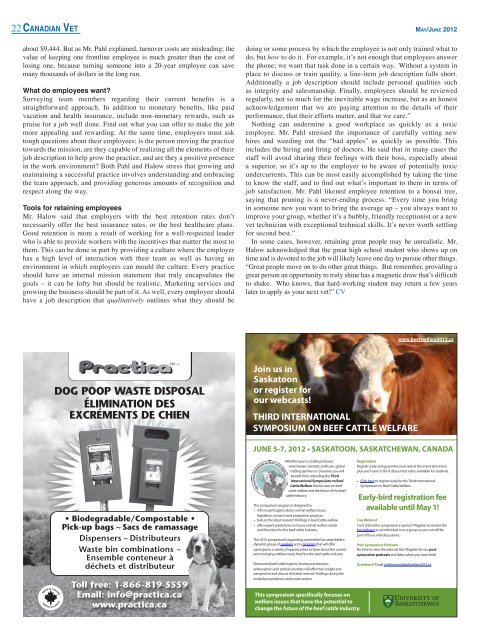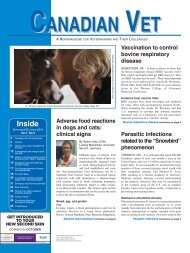canadian vet - K2 Animal Health Publishing
canadian vet - K2 Animal Health Publishing
canadian vet - K2 Animal Health Publishing
You also want an ePaper? Increase the reach of your titles
YUMPU automatically turns print PDFs into web optimized ePapers that Google loves.
22 Canadian Vet<br />
May/June 2012<br />
about $9,444. But as Mr. Pahl explained, turnover costs are misleading; the<br />
value of keeping one frontline employee is much greater than the cost of<br />
losing one, because turning someone into a 20-year employee can save<br />
many thousands of dollars in the long run.<br />
What do employees want?<br />
Surveying team members regarding their current benefits is a<br />
straightforward approach. In addition to monetary benefits, like paid<br />
vacation and health insurance, include non-monetary rewards, such as<br />
praise for a job well done. Find out what you can offer to make the job<br />
more appealing and rewarding. At the same time, employers must ask<br />
tough questions about their employees: is the person moving the practice<br />
towards the mission, are they capable of realizing all the elements of their<br />
job description to help grow the practice, and are they a positive presence<br />
in the work environment? Both Pahl and Halow stress that growing and<br />
maintaining a successful practice involves understanding and embracing<br />
the team approach, and providing generous amounts of recognition and<br />
respect along the way.<br />
Tools for retaining employees<br />
Mr. Halow said that employers with the best retention rates don’t<br />
necessarily offer the best insurance rates, or the best healthcare plans.<br />
Good retention is more a result of working for a well-respected leader<br />
who is able to provide workers with the incentives that matter the most to<br />
them. This can be done in part by providing a culture where the employer<br />
has a high level of interaction with their team as well as having an<br />
environment in which employees can mould the culture. Every practice<br />
should have an internal mission statement that truly encapsulates the<br />
goals – it can be lofty but should be realistic. Marketing services and<br />
growing the business should be part of it. As well, every employee should<br />
have a job description that qualitatively outlines what they should be<br />
doing or some process by which the employee is not only trained what to<br />
do, but how to do it. For example, it’s not enough that employees answer<br />
the phone; we want that task done in a certain way. Without a system in<br />
place to discuss or train quality, a line-item job description falls short.<br />
Additionally a job description should include personal qualities such<br />
as integrity and salesmanship. Finally, employees should be reviewed<br />
regularly, not so much for the inevitable wage increase, but as an honest<br />
acknowledgement that we are paying attention to the details of their<br />
performance, that their efforts matter, and that we care.”<br />
Nothing can undermine a good workplace as quickly as a toxic<br />
employee. Mr. Pahl stressed the importance of carefully <strong>vet</strong>ting new<br />
hires and weeding out the “bad apples” as quickly as possible. This<br />
includes the hiring and firing of doctors. He said that in many cases the<br />
staff will avoid sharing their feelings with their boss, especially about<br />
a superior, so it’s up to the employer to be aware of potentially toxic<br />
undercurrents. This can be most easily accomplished by taking the time<br />
to know the staff, and to find out what’s important to them in terms of<br />
job satisfaction. Mr. Pahl likened employee retention to a bonsai tree,<br />
saying that pruning is a never-ending process. “Every time you bring<br />
in someone new you want to bring the average up – you always want to<br />
improve your group, whether it’s a bubbly, friendly receptionist or a new<br />
<strong>vet</strong> technician with exceptional technical skills. It’s never worth settling<br />
for second best.”<br />
In some cases, however, retaining great people may be unrealistic. Mr.<br />
Halow acknowledged that the great high school student who shows up on<br />
time and is devoted to the job will likely leave one day to pursue other things.<br />
“Great people move on to do other great things. But remember, providing a<br />
great person an opportunity to truly shine has a magnetic draw that’s difficult<br />
to shake. Who knows, that hard-working student may return a few years<br />
later to apply as your next <strong>vet</strong>!” CV<br />
www.beefwelfare2012.ca<br />
DOG POOP WASTE DISPOSAL<br />
ÉLIMINATION DES<br />
EXCRÉMENTS DE CHIEN<br />
Join us in<br />
Saskatoon<br />
or register for<br />
our webcasts!<br />
THIRD INTERNATIONAL<br />
SYMPOSIUM ON BEEF CATTLE WELFARE<br />
• Biodegradable/Compostable •<br />
Pick-up bags ~ Sacs de ramassage<br />
Dispensers ~ Distributeurs<br />
Waste bin combinations ~<br />
Ensemble conteneur à<br />
déchets et distributeur<br />
Toll free: 1-866-819-5559<br />
Email: info@practica.ca<br />
www.practica.ca<br />
TM<br />
JUNE 5-7, 2012 • SASKATOON, SASKATCHEWAN, CANADA<br />
Whether you’re a cattle producer,<br />
<strong>vet</strong>erinarian, scientist, politician, global<br />
trading partner or consumer, you will<br />
benefit from attending the Third<br />
International Symposium on Beef<br />
Cattle Welfare that focuses on beef<br />
cattle welfare and the future of the beef<br />
cattle industry.<br />
The symposium program is designed to:<br />
• inform participants about animal welfare issues,<br />
legislation, research and production practices<br />
• feature the latest research findings in beef cattle welfare<br />
• offer expert predictions on future animal welfare needs<br />
and directions for the beef cattle industry.<br />
The 2012 symposium’s organizing committee has assembled a<br />
dynamic group of speakers and a program that will offer<br />
participants a variety of opportunities to learn about the current<br />
and emerging welfare issues that face the beef cattle industry.<br />
Renowned beef cattle experts, bovine practitioners,<br />
philosophers and animal scientists will offer their insight and<br />
perspective and discuss the latest research findings during the<br />
invited presentations and poster session.<br />
This symposium specifically focuses on<br />
welfare issues that have the potential to<br />
change the future of the beef cattle industry.<br />
Registration<br />
Register early and guarantee your seat at this important event,<br />
plus you’ll save $100! A discounted rate is available for students.<br />
• Click here to register early for the Third International<br />
Symposium on Beef Cattle Welfare.<br />
Early-bird registration fee<br />
available until May 1!<br />
Live Webcast<br />
Can’t attend the symposium in person? Register to receive the<br />
live webcast as an individual or as a group so you can still be<br />
part of these vital discussions.<br />
Post-Symposium Podcasts<br />
No time to view the webcast live? Register for our postsymposium<br />
podcasts and listen when you have time!<br />
Questions? Email conference@beefwelfare2012.ca





